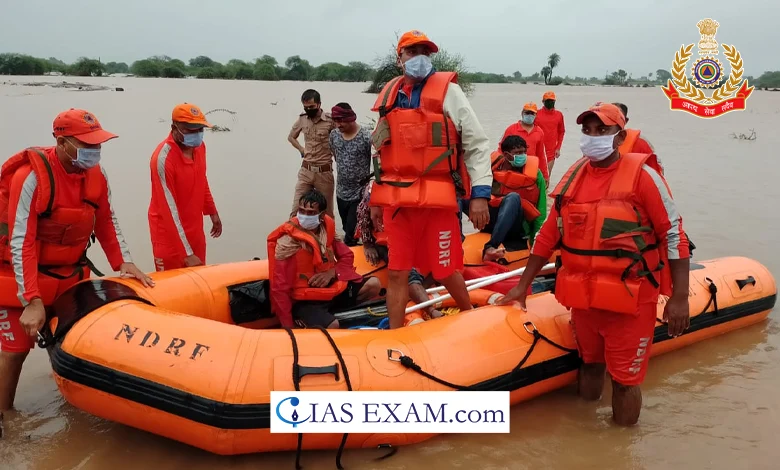National Disaster Relief Fund (NDRF)
Syllabus: Geography [GS Paper-1]

Recent News
The recent disagreement between Tamil Nadu, Karnataka, and the central government regarding the release of the National Disaster Relief Fund (NDRF) highlights weaknesses in India’s disaster management system, leading to delays in providing assistance and hampering recovery efforts.
More on news
- Tamil Nadu has approached the Supreme Court seeking disaster relief funds from the Centre. This claim arises from the aftermath of Cyclone Michaung and the consequential floods that devastated the state in December 2023.
- The Calamity and Its Impact: In the month of December in 2023 cyclonic storm Micheal churned across Tamil Nadu and was the worst in over a decade. While floods followed the cyclone, which contributed to the large-scale infrastructure destruction, houses damage and agricultural land impoverishment, the state budget faced a heavy economic consequence.
- Legal Framework for Disaster Relief: The Disaster Management Act of 2005 (DMA) is an act of law that gives legal guidelines for relief operations which occur due to disasters in India. Under this act, funds for disaster relief are available from two primary sources: the SDRF and the NDRF of the State Disaster Relief Fund (SDRF) and the National Disaster Relief Fund (NDRF).
- Tamil Nadu’s Claim: Tamil Nadu state is urging for the allocation of about ₹37,000 crore from NDRF fund. This covers around ₹19,692.69 crore for destruction by cyclones and another ₹18,214.52 for rainfall of never experienced intensity in districts in the southern parts of the country.
- Centre-State Dynamics: The state is of opinion that though all the necessary documentary compliances and IMCT evaluations are completed by it, the Central agency still is not ready to sanction the contributions. Tamil Nadu stands that the failure to implement the order pinpointed by the DMA is in remission of the said law as well as the fundamental liberties of its citizens under Article 14 and 21 of the Constitution.
- Supreme Court Involvement: Tamil Nadu has filed a suit under Article 131 of the Constitution, invoking the Supreme Court’s original jurisdiction to resolve disputes between states and the Centre. The state seeks a directive for the immediate release of funds and contends that the delay is causing hardship to the affected population.
National Disaster Relief Fund (NDRF)
- The National Disaster Relief Fund (NDRF) is a state-owned organisation instituted to give out the budget to support delivery of timely interventions, crisis response and risk reduction.
- Purpose and Objectives: Providing of immediate relief and assistance is the major task of the NDRF team, designed for responsible for the rescue work in much of the areas affected by such natural calamities such as floods, earthquakes, cyclone, droughts, and any type of calamities.
- Management and Administration: NDRF is commonly organised on the government’s level and supervised by particular acts of legislation concerning disaster management. In India, the NDMA, which works under the Disaster Management Act of 2005, is the supervising authority.
- Allocation and Utilisation of Funds: NDRF money is diverse as it is used for multiple purposes, like emergency aid such as search and rescue, temporary sheltering, food, water etc. and rehabilitation of damaged infrastructures.
- Legal Framework: Legal structures and guidelines as provided by relevant disaster management legislation provide guidance for the creation and operation of the NDRF, which enables proper administration and traceability during the use of the fund.
- Supplementary Contributions: The NDRF may supplement its own fund with grants from the government central, as well as other countries or organisations` monetary supports, to enlarge its resources for the rescue operations after natural disasters.
- Role in Disaster Preparedness and Response: The NDRF are the key actors who take care of disaster preparedness, operation during response and recovery after the disaster. They make sure that quick response operations are on terrs while providing logistics, technical help and other support services during times of crises to the suffering communities.
- Impact and Importance: To reduce the kind of casualties and property losses, NDRF has to respond promptly with the provision of thorough assistance to the disaster-struck regions by means of contributing to overall disaster resilience of the community and its recovery process.
Conclusion
The disagreement over disaster relief funds showcases the difficulties in the relationship between the central government and state governments in handling the aftermath of natural disasters. Tamil Nadu’s request emphasises the importance of receiving prompt financial aid to help with recovery and reconstruction efforts for those impacted by disasters.
Source: The Indian Express
UPSC Mains Practice Question
Q.Discuss the recent dispute between Tamil Nadu, Karnataka, and the central government over the release of the National Disaster Relief Fund (NDRF). Analyse the implications of such disagreements on India’s disaster management system, focusing on the delays in providing assistance and their impact on recovery efforts.





.png)



